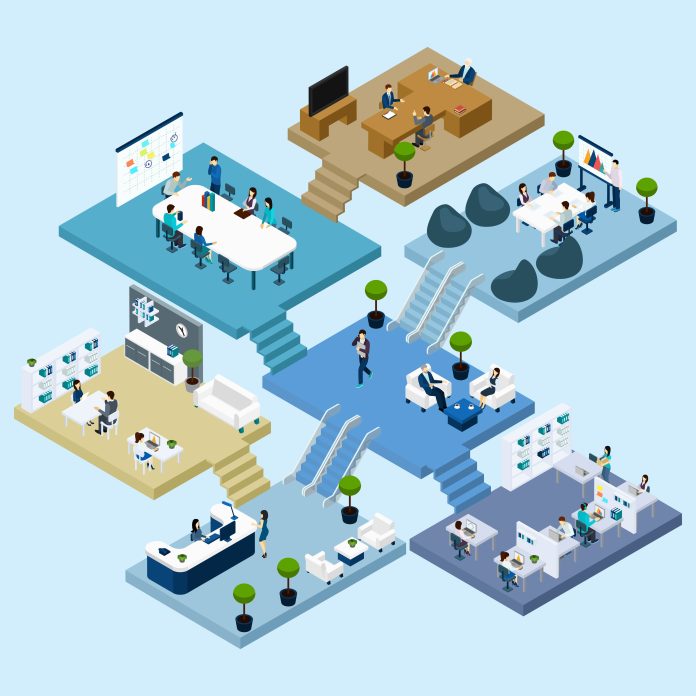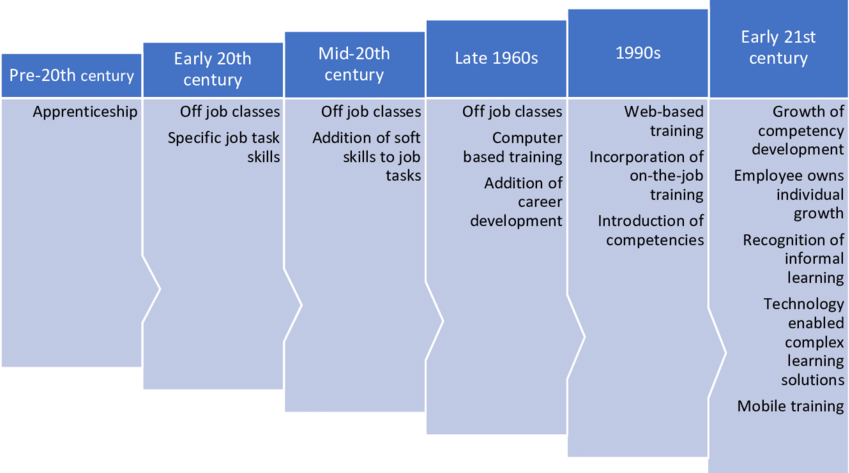
Workplace learning has undergone a dramatic and multifaceted transformation over the last six decades. From rigid, instructor-led classrooms and printed manuals to AI-powered learning platforms and immersive virtual simulations, the evolution of workplace learning reflects the broader technological, economic, and cultural shifts shaping how we work and grow.
Understanding this evolution is crucial for organisations striving to stay competitive and meet the demands of a new generation of learners. This article takes a comprehensive look at how corporate training has progressed from the 1960s through to the 2020s, identifying key milestones and exploring future trends in learning and development.

The Evolution of Workplace Learning in the 1960s: The Era of Apprenticeships and Manuals

In the 1960s, workplace learning was primarily hands-on and hierarchical. Most training took place through formal apprenticeships, which allowed new employees to learn by shadowing more experienced colleagues. Alternatively, workers attended instructor-led sessions that emphasised rote learning and repetition. Printed training manuals were the cornerstone of learning—dense, unchanging, and often challenging to digest.
Knowledge transfer was slow and uniform, with little consideration for individual learning styles or flexibility. Although some consider the 1960s a “golden age” due to economic stability and job availability, it was also a time marked by generational divides. Young, formally educated workers often faced resistance or misunderstanding from older, experience-based colleagues, creating tensions that impacted learning and collaboration.
Despite its limitations, the 1960s laid the groundwork for the concept of structured learning in the workplace. It was during this time that companies began recognising the importance of formal training, especially in skilled trades and industrial roles. Though the tools were basic and the methods somewhat inflexible, it marked the start of what would become a lifelong learning journey in many professions.
The Evolution of Workplace Learning in the 1970s: Government Steps In
As economic shifts created barriers to youth employment in the 1970s, the UK government launched several landmark initiatives to support workforce entry and development. The Work Experience Scheme (1976) was introduced to give school-leavers practical job experience.
Two years later, the Youth Opportunities Programme (1978) was launched, offering vocational training and short-term work placements to unemployed young people. These initiatives acknowledged a growing need to make workplace learning more inclusive and structured.
For the first time, government policy directly supported the transition from education to employment, recognising that targeted workplace learning could significantly improve employability and bridge economic gaps.
The programs of the 1970s also encouraged employers to think differently about onboarding and skill development. The concept of combining on-the-job training with vocational support outside the organisation took root, setting the stage for employer-sponsored programs and partnerships with educational institutions.
It was a time of realisation that learning could no longer be left solely to experience; it had to be guided and supported to meet the demands of a growing, more diverse workforce.
The Evolution of Workplace Learning in the 1980s: The Arrival of Computers and Multimedia

The 1980s marked the beginning of a digital revolution in the workplace. As personal computers became increasingly common, organisations were forced to introduce wide-reaching training initiatives to equip their staff with new technical skills.
Instructor-led training sessions remained popular, but now included digital tools like PowerPoint, which became synonymous with corporate presentations. Training videos also gained traction, offering visual demonstrations of tasks and concepts.
Technologies such as Computer-Assisted Instruction (CAI) and Interactive Video Training began making inroads, allowing learners to interact with content at their own pace. While these formats lacked the interactivity of modern systems, they laid the foundation for computer-based learning by making training more engaging and repeatable.
This decade also saw a significant cultural shift. The companies started viewing training not as a one-time onboarding task but as a recurring process to match the pace of technology.
As jobs became more complex and technology-dependent, upskilling and reskilling became a priority. The seeds of the modern learning and development function were sown, expanding the role of HR teams and training departments.
The Evolution of Workplace Learning in the 1990s: The Birth of eLearning
The 1990s ushered in a wave of innovation in workplace learning, due in large part to the rise of the internet and advances in multimedia technology. In 1997, the term “eLearning” began gaining popularity, as organisations started exploring how digital platforms could streamline training.
The emergence of Learning Management Systems (LMS) transformed how content was delivered and tracked, making training more measurable and manageable. CD-ROM-based learning offered a more interactive and visually rich experience than previous formats, supporting self-paced and modular training approaches.
As IT roles expanded and digital fluency became essential, the demand for scalable, accessible training solutions surged. Online learning emerged as a crucial component of workforce development.
eLearning helped decentralise training, making it possible for employees across various locations to receive consistent training content. This period also introduced quizzes, tracking scores, and course completion certifications—giving companies better visibility into workforce readiness and compliance. For many industries, this shift marked the first time learning outcomes could be easily monitored, reported, and improved.
The Evolution of Workplace Learning in the 2000s: Strategic Skills Development and National Focus
In the early 2000s, learning and development moved from being a support function to a strategic priority. The UK government’s Skills Strategy White Paper in 2003 called for a national “skills alliance” involving employers, employees, and educators. This vision aimed to raise the skill level of the national workforce to compete in a global economy.
The Leitch Review of Skills in 2006 reinforced this commitment, recommending that 95% of adults achieve at least a Level 2 qualification and that apprenticeship numbers increase significantly.
The formation of the UK Commission for Employment and Skills in 2008 further institutionalised the government’s role in promoting lifelong learning. These developments reinforced the idea that a highly skilled workforce was not only desirable but necessary for national prosperity.
During this era, corporate L&D budgets began aligning with business outcomes. Organisations began to tie training effectiveness to employee performance, retention, and return on investment (ROI).
The concept of continuous learning gained momentum, and workplace learning platforms began to resemble ecosystems—incorporating mentoring, cross-functional skills, and leadership development.
The Evolution of Workplace Learning in the 2010s to Present: The Rise of AI and Personalised Learning
From the 2010s onward, workplace learning has entered a period of rapid technological advancement, with artificial intelligence (AI) playing a central role. AI now powers platforms that assess learner profiles, deliver personalised content, and adapt in real-time based on performance and engagement.
The mobile-first world has enabled employees to learn from anywhere, whether on a commute, between meetings, or during lunch breaks. Microlearning—short, focused learning segments—has become popular for its ability to provide just-in-time knowledge.
Cloud-based platforms and robust analytics have further revolutionised how learning impact is measured. Learning is no longer limited to static courses; it is now embedded in workflows, tailored to personal development goals, and aligned with business outcomes.
Moreover, L&D professionals now have access to deep learning insights and behavioural data, allowing them to make informed decisions about skill gaps and training pathways.
AI not only personalises learning but also automates routine L&D functions, freeing up resources for strategic development.
The learner experience is now central, and content design has evolved to mirror consumer-grade experiences—intuitive, visual, and accessible.
Is This the New Golden Age of Learning?
With the convergence of virtual reality (VR), adaptive learning, and AI-driven insights, the modern era could be considered the new golden age of workplace learning. Today, training is not only more accessible but also more impactful.
Learners engage with realistic simulations, receive real-time feedback, and can instantly apply what they learn. Digital transformation has enabled learning to be more scalable and cost-effective than ever before.
While traditional formats like in-person workshops still hold value, particularly for hands-on skills and leadership development, the flexibility and personalisation of digital learning make it indispensable in today’s fast-paced world.
Learning is also becoming more collaborative, with peer learning, internal knowledge sharing, and community-based platforms gaining popularity. Social learning has emerged as a powerful layer, making learning more interactive and aligned with day-to-day operations.
What Modern Learners Expect from the Evolution of Workplace Learning

Modern employees are increasingly self-directed and expect workplace learning to align with the pace and flexibility of their everyday routines. They value training experiences that are directly applicable to their current job responsibilities, delivered in a format that is accessible across various devices.
The modern learner prefers bite-sized lessons that are easy to understand and immediately applicable, helping them stay engaged without overwhelming their schedule. In addition, adaptive learning paths tailored to individual skill levels and long-term career goals are now considered essential components of effective training.
Beyond these core needs, today’s workforce is drawn to interactive learning formats that include gamification and recognition, providing motivation and a sense of progress. Employees also value learning that supports career advancement, helping them build skills that lead to upward mobility.
Organisations that acknowledge and respond to these expectations are more likely to cultivate a culture of continuous improvement, increase employee engagement, and achieve sustained performance gains across their teams.
The Future of Workplace Learning

Looking forward, the integration of next-generation technologies will continue to shape workplace learning. VR will allow employees to immerse themselves in realistic scenarios without real-world risks.
Machine learning will further refine personalisation, automating recommendations and assessments based on behavioural patterns and learning history. Learning platforms will increasingly function as digital coaches, supporting not just skill acquisition but holistic career development.
Sustainability, DEI (Diversity, Equity & Inclusion), and wellness will also become learning priorities. As workforce expectations expand, so too will the scope of corporate training. Companies that embrace a forward-looking, employee-centric approach to L&D will gain a distinct competitive edge.
At FAME Meta, we are leading this evolution. Our eLearning solutions combine the best of technology, design, and pedagogy to deliver experiences that are engaging, measurable, and aligned with organisational goals. Whether you are focused on compliance training, leadership development, or technical upskilling, FAME META ensures that your workforce remains future-ready!

